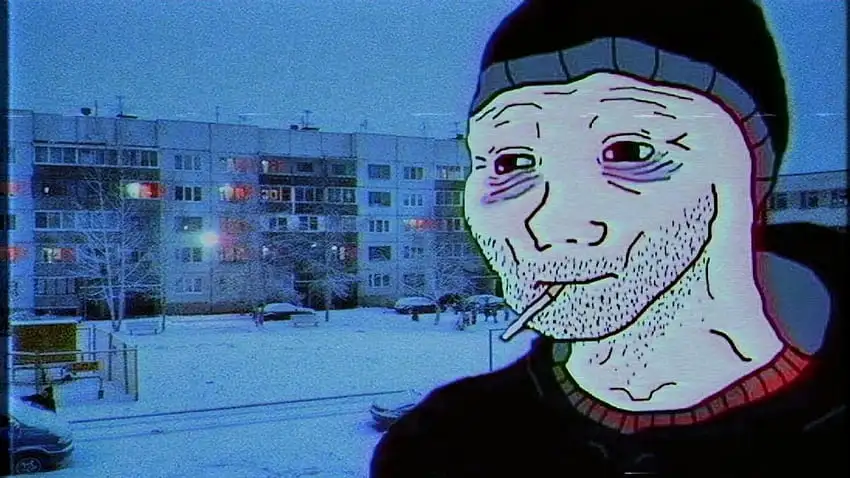Right now, the world is at boiling point. It may not seem like it from the way our society is acting, but if we don’t do something to tackle climate change and the manifold issues that’ll be brought with it, we will see our planet transformed by environmental cataclysm. Most young people are aware of the toll that advanced capitalism has put on the planet’s ecosystems. However, many have yielded to a listless mentality –– doomerism. It is the duty of Marxist-Leninists to convince them that there is still a sliver of hope left to save the planet.
The ‘doomer’ is essentially an alienated capitalist subject. Through witnessing capitalism’s destruction of the planet and feeling like they are unable to counteract it, they give up on hoping to improve the world, accepting that the planet will one day be subsumed by the coming apocalypse. Statistics illustrate how endemic this defeatism has become – over half of young people aged 16-25 believe our planet is doomed. On top of that, around 45% have admitted that climate anxiety is affecting their day-to-day lives.
Doomerism is now so prevalent amongst young people that it has become its own morbid subculture. The term ‘doomer’, a play on ‘boomer’ on a 4chan climate-apocalypse-prepper thread in 2018, it later went viral, gaining traction on mainstream social media platforms. Nowadays, ‘doomers’ are stereotyped as listening to Post-Soviet New Wave Bands such as Molchat Doma, binging on Adam Curtis documentaries, spending unhealthy amounts of time on social media, and posting images of depressed Wojaks. Being a ‘doomer’ has in a sense become cool and ‘aesthetic’ for many young people. However, this assessment belittles a serious and legitimate existential dread amongst young people, by masquerading it as merely the new sulky ‘emo’ subculture.
See, doomerism isn’t just an online trend. It reflects the despondence and behaviour of most young people today. Studies indicate its prevalence, seen by the rise in anxiety among young people; the increasing interest in voluntary childlessness; and the reluctance of many to get involved in activism, to name but a few issues. Obviously, apocalypticism has existed since the dawn of time –– be it the Mayans or a millenarian cult. But unlike the vague mysticism surrounding the years 2000 and 2012, we now have quantifiable scientific evidence that the planet’s ecosystems are on borrowed time.
By the year 2050, there will be an estimate of 1.2 billion climate refugees and the extinction of 1/3 plant and animal species. Antarctica is losing 151 billion tonnes of ice per year, the equivalent weight of Mount Everest’s rock composition. As the arctic permafrost begins to melt, CO2 trapped underneath is released into the atmosphere, further exacerbating the crisis. STAT Climate change is increasing the risk of extreme weather events such as forest fires, droughts, floods, and storms happening.
At this year’s COP27, even the UN General Secretary António Guterres went as far as saying:
“Our planet is fast approaching tipping points that will make climate chaos irreversible… We are on a highway to climate hell with our foot still on the accelerator.”
It seems even the Political Establishment have been ‘blackpilled’ on the impending climate apocalypse.

Are we really doomed?
“You wouldn’t abandon ship in a storm just because you couldn’t control the winds.” ― Thomas More (Utopia)
It is amazing to think that there has been such little resistance to environmental catastrophe. Scientists have been ringing the alarm bells for decades, and yet, it feels like their warnings have been completely ignored. You’d honestly expect more people to be throwing their lives on the line to save our planet. The prospect of living underwater as a result of rising sea levels, is surely enough to make people do something?
As the adage in Mark Fisher’s Capitalist Realism goes: “It is easier to imagine the end of the world than it is capitalism.” As a result of this logic, a lot of people have ultimately given up fighting against the tide. Fisher himself obviously wanted a revolution to come about, but he believed that most of the world saw it “impossible even to imagine a coherent alternative” to capitalism. His ideas have become highly influential in the world of academia and have made him one of the 21st century’s most famous Marxists. One could argue that the reason Fisher’s book became so popular, even among liberals, was because of its underlying pessimism. As a result, his ideas weren’t necessarily considered a threat to the status quo: The Establishment wants us to be doomers. It keeps us resigned from ever trying to build an alternative to their system.
We need to fight this debilitating narrative and let our class know that we must, can, and will one day overcome capitalism.
How will Marxism-Leninism save the planet?
Through this ecological turmoil, we will be responsible for persuading the public to engage in revolutionary struggle. As the world goes into meltdown, the capitalist system will struggle with providing any semblance of living standards that might placate the people. When the imperialists will struggle to extract natural resources and meet the demands of the population, we will see economic turmoil and social instability. With this destabilisation of capitalism, the gap between the wealthiest and poorest in society, and livelihoods of the global working class, will be in such a dire situation that we are going to see riots, lootings, alongside coups and revolutions. As Marxist-Leninists, we need to possess the leadership, organisation, and strategy required to seize upon this revolutionary potential.
Marxism-Leninism is the antithesis of doomerism –– it is the revolutionary ambition that sets the ideology apart from debilitating ones. Marxist-Leninists de facto accept that the only way to systematically change society is through revolution. Therefore, to be a Marxist-Leninist, you must believe that revolution is one day possible, and that it is your duty to sow fertile ground for such possibilities. Although many democratic socialists have dedicated their time to fighting for environmentalist causes, we know for a fact that the only way to realise a truly non-destructive form of society will be through the elimination of capitalism.
“The revolutionary knows he or she will risk death but chooses to fight to improve the conditions for their community rather than submit to the existing state that has created these conditions.” – Huey Newton (Revolutionary Suicide)
Contrastingly, revolutionary suicide is when an individual is prepared to become a martyr for what they believe in; willing to lose their life to save their community, and ultimately, the planet.
Since Marx himself, Marxists have dreamt up ideas of how to counter the destructive elements of industrial society. In the past few decades, systems theorists and cyberneticians have sketched out models of socialist planning to illustrate what the world could be like under communist governance. The essay ‘Facing the ecosocial crisis: Is a socialist planning of the economy feasible?’ by Guillermo Murcia, Víctor Castillo, Maxi Nieto is just one example of how “a planned communist economy will allow us to overcome the enormous challenges, whether they are social, ecological, or public-health related, that humanity faces today.” Most importantly, the three academics stress that the model they have drawn up is not just some grandiloquent utopian drivel, but a viable alternative that can one day be implemented to save our planet. For them, a planned socialist economy is able to maintain environmental equilibrium. They set out 3 different models: “linear programming, algorithms that maximize a specific function that represents the adjustment between what is produced and what is consumed, or through the structure of a national economy as if it were a neural automatized network.”
Understandably, such models are difficult for the layperson to comprehend. But the fact that we have such sketches should embolden us. We are not just staring into the abyss; we have the tools to guide us out of this hellhole we are veering into. Through a distinctly centralised Marxist-Leninist economic paradigm, we are able to steer the planet in ways that the current neoliberal order could never achieve.

World 2.0: Why revolution is possible.
“What we are discussing is the indisputable and fundamental duty of all socialists — that of revealing to the masses the existence of a revolutionary situation, explaining its scope and depth, arousing the proletariat’s revolutionary consciousness and revolutionary determination, helping it to go over to revolutionary action, and forming, for that purpose, organisations suited to the revolutionary situation.” – Lenin, The Collapse of The Second International
Climate scientists Marshall Burke and Solomon Hsiang are experts on the relationship between conflict and climate change. In their report on the topic, the pair argue that for every half-degree of warming, the increase in conflicts around the world will rise by around 10-20%. Writing at a time when, the albeit flawed Doomsday Clock is apparently the closest it’s ever been (90 seconds to midnight), it is fair to assume that we’ll continually be inching closer and closer to the midnight point in the next few decades. Nothing in climate science is straightforward, but the calculation is terrifying: The number of wars on a five-degree warmer globe would be at least double what they are now. Of course, this has the potential to fuel nuclear fallout, or even a mass-genocide.
But at the same time it’s not all doom and gloom –– revolution is still on the horizon. It’s extremely likely that revolutions will be popping up around the world in the not so distant future. Our role is to ensure that those revolutions are guided by Marxism-Leninism and not by reactionary ideas, as we have seen in the Arab Spring. This will solely depend on our ability to organise and agitate amongst the working class in time for those ripe conditions that make revolution fertile emerge.
Therefore, as Marxist-Leninists, we will have to channel these raw emotions and social instability and convince people to centre it at governments so that we can realise revolution. As the world continues to be destroyed, we need to keep increasing our agitation amongst the working class and show them who the people are that are causing all this damage. Through highlighting such issues, we will manage to get people on our side. The emergence of revolutions in response to ecological breakdown will be inevitable. Some of them may be reactionary regardless of our attempts, and most of them will definitely occur in the Global South (the areas most affected by climate change.)
We can’t let the minds of our generation get transfixed by the debilitating fatalism of doomerism. It is our duty to ensure that an equal and just communist society blossoms out of this chaos. Only communism can truly save our planet from the pollution that is capitalism. Our time is now.
Would you rather die fighting for what you believe in, or die knowing that you let the world fall into decay?
Tomasz Nowak



